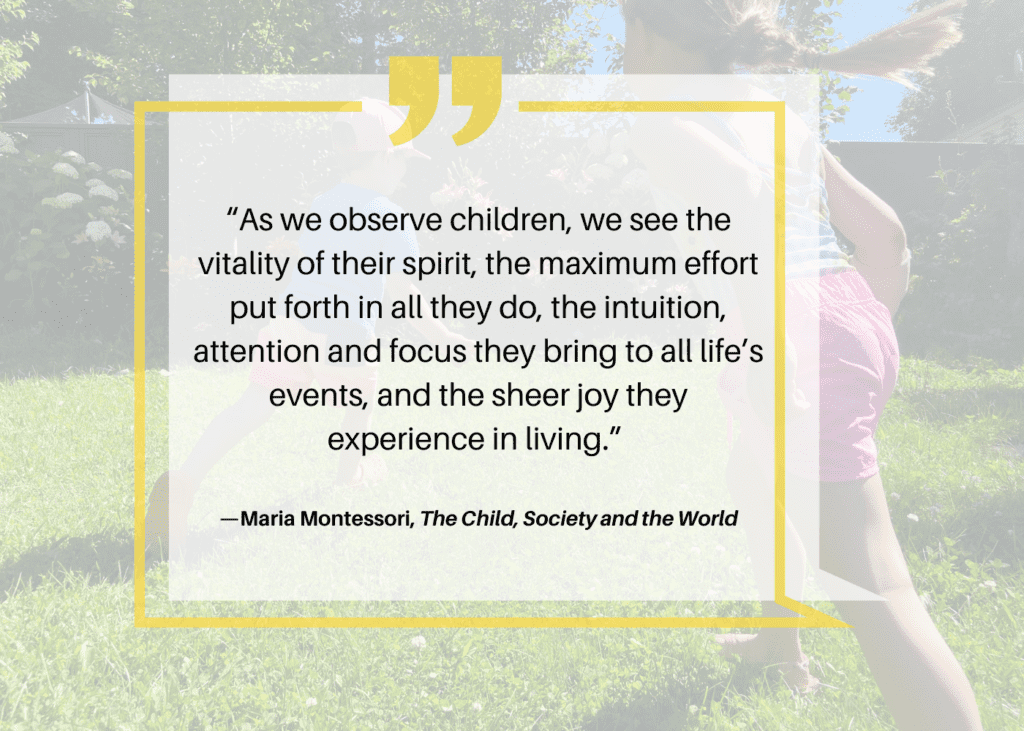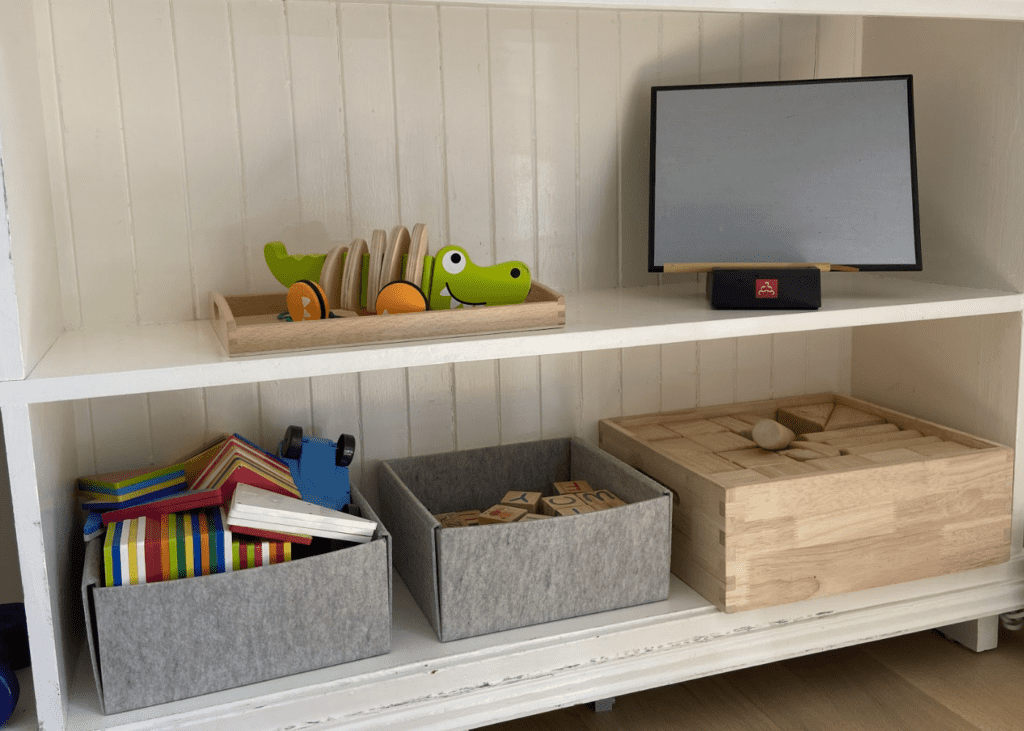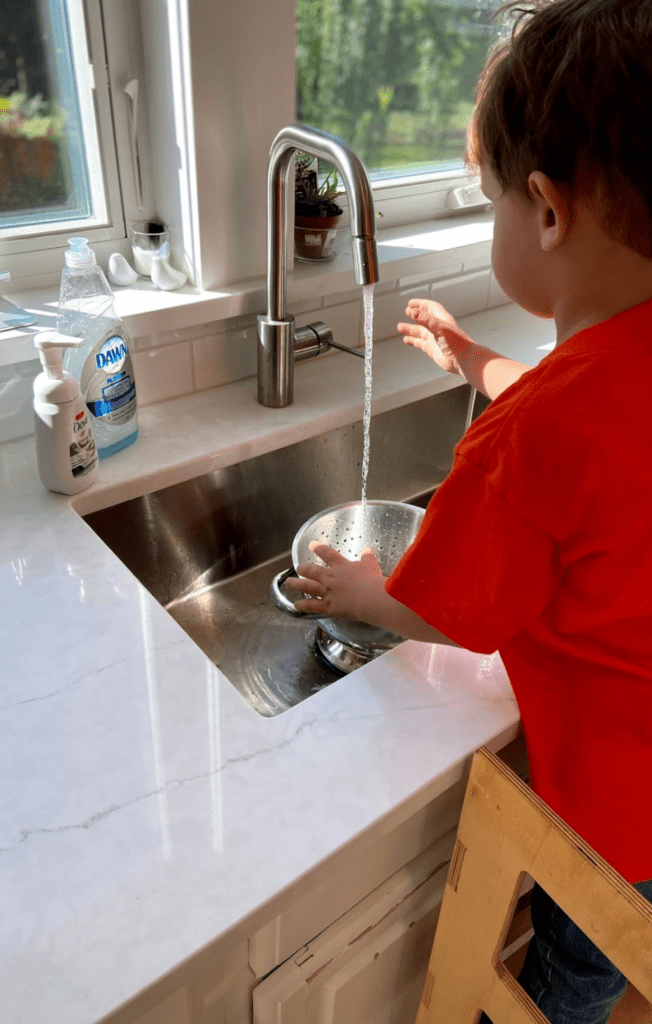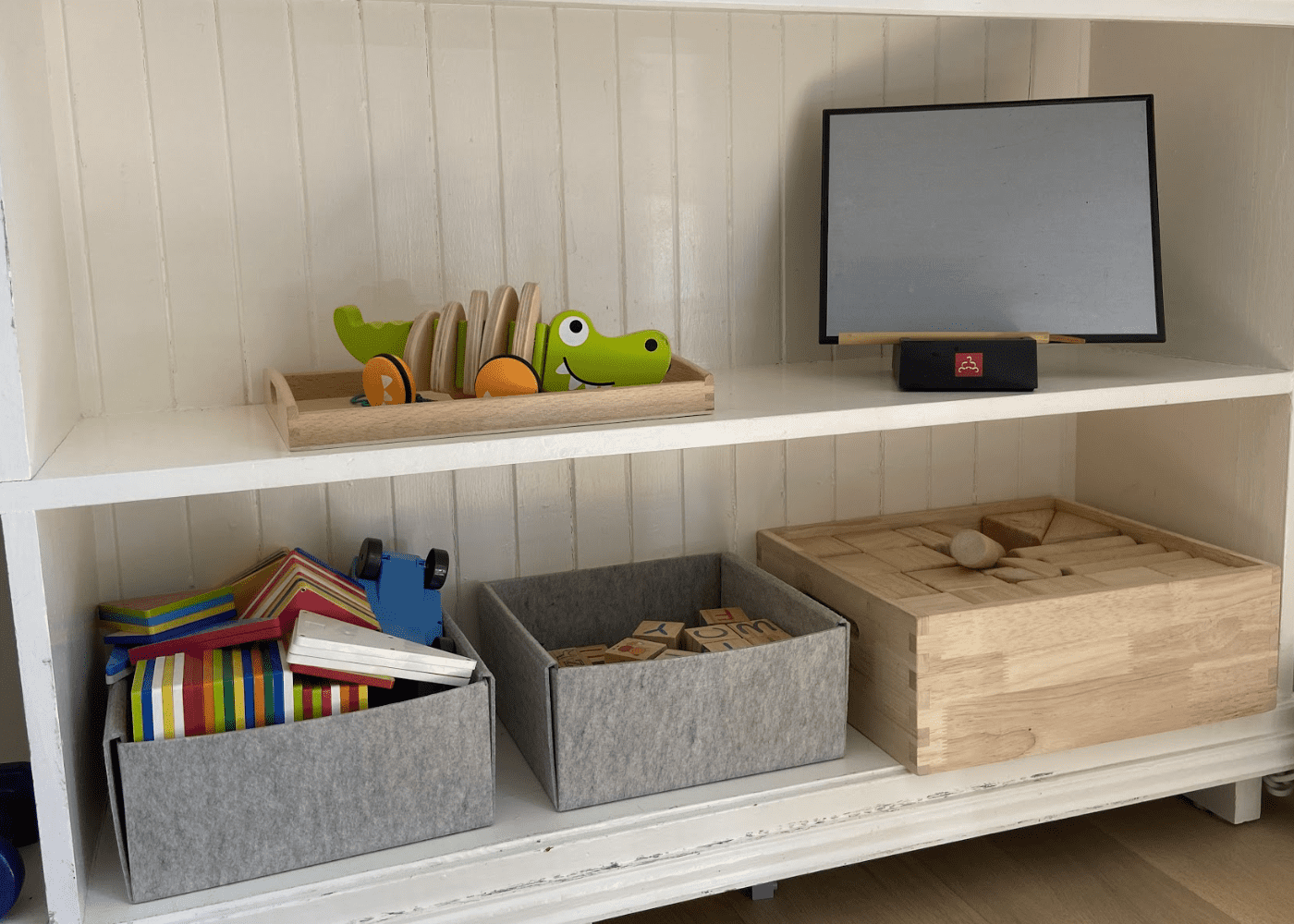The Montessori method is becoming increasingly popular. In fact, Forbes says the last 20 years have brought increased opportunities for public Montessori education. The increasingly popular education method has also inspired families to integrate Montessori principles into the home, too.
This article will cover what a ‘Montessori home’ looks like and why parents are choosing to implement Montessori strategies in their home environment. We’ll also share some tips for Montessori at home.

What is the Montessori method?
The Montessori method is an educational philosophy that was developed in the 1900s by Maria Montessori. She had a vision of an educational environment that emphasized hands-on learning, practical skills, self-motivation, and empowerment of the individual child.
Maria Montessori’s vision…
“My vision of the future is no longer of people taking exams and proceeding on that certification… but of individuals passing from one stage of independence to a higher, by means of their own activity, through their own effort of will, which constitutes the inner evolution of the individual.”
Introduction, From Childhood to Adolescence, The Clio Montessori Series, by Maria Montessori
If you want to learn more about Montessori principals and what this type of schooling would look like for your child’s education, I’d read the article I linked above.
But for now, let’s look at what it looks like to integrate the Montessori approach at home!

What is a Montessori-friendly home?
Ashley from the Hapa Family has an amazing video overviewing the history of Montessori (including the benefits). Skip to about 3:55 if you’re only wondering what Montessori in the home looks like!
Amanda says that a Montessori parent should act as a guide in a Montessori home. She also mentiones that a Montessori home should offer a prepared Montessori learning environment, meaningful learning opportunities, and emphasize principles of respect, freedom, and independence.
Many of these concepts are echoed in the American Montessori Academy’s post, Beyond the Classroom, which I would suggest reading too.
Here are some ways to integrate Montessori at home:
The parent’s role: A guide (or facilitator)
Giving children their own space to learn, grow, and explore their interests while being a part of the everyday life responsibilities at home, is fundamental.
Prepared environment
Offering thoughtfully prepared and intentional toys and activities in the home creates the ‘prepared environment.’ Most importantly, the home environment is designed with the child in mind.
Think of it this way: How can you set up your home to be accessible and functional for your child? You’ll want to include child-sized furniture so they can participate in practical life activities without needing parental assistance. I go into more detail about Montessori furniture in this article.
If you want to hang interesting artwork in their rooms, you would hang it at their level (so that they can actually enjoy and appreciate it!). The same goes for plants! Teaching them young children how to care for plants is awesome, but they can’t appreciate and care for them if they can’t reach them.
A place for everything and everything in its place! Decluttering is another important aspect. Clutter not only makes it more difficult to learn, but it often means that the room is filled with unnecessary items. Focus on toys, activities, and furniture that have a purpose and add value to the room. Maria Montessori also emphasized the child’s natural sense of order, which the prepared environment caters to.
BTW, you might also enjoy our other article, What is Montessori parenting?

Intentional toys & toy rotation
When designing your Montessori-inspired playroom, there are a few Montessori principles you can integrate.
Offer intentional toys: Simple, durable, purposeful, and hands-on. The toys are offered on low shelves or bins where the children can see and easily access them (often open shelves with a tray or basket for each activity). Games and materials are made of natural materials and are geared at teaching the children either a specific skill or are smaller versions of common objects so children can practice real-life skills.
Having meaningful learning materials offers more opportunities for learning without the children having to ask for a specific activity or having to dig through a toy bin to find what they are looking for. To promote a certain skill level or personal interest, toys are also rotated. This lets your child have multiple play options while making sure they engage with all of their toys, compared to a toy bin where some items will be left unplayed with.
For more in-depth articles about Montessori toys or Montessori toy storage, check out our other posts!
Mutual respect
Parents can create the right environment to support an environment of mutual respect. This means viewing the children as competent and capable human beings, no matter their age or individual needs. By establishing firm and clear but loving boundaries, which Amanda refers to as “positive parenting,” clear expectations can be set to help guide young ones as they learn and grow in their early years.
Respect for the child’s play is another important aspect – A child’s Montessori education looks at playing as work. Younger children are building essential skills and learning concepts that will carry them through their adolescent lives.
Freedom & independence
As long as the children have a safe space to learn and grow, and their boundaries are clearly outlined, parents can apply Montessori principles of freedom and independence in many ways. In Montessori methods, this may look like:
Freedom of expression. Letting children choose their outfits (as long as they are appropriate for the weather) is a great example of this.
Meal preparation. Allowing children to participate in food preparation, by making their own healthy snacks, for example, is a great way to give them autonomy at meal time.
Care for self, others, and environment. As we’ve established, the Montessori approach favors teaching children independence and responsibility from a young age. This may look like an expectation of the child’s bedroom being tidied by them, practice putting their own toys away, caring for plants and animals, or learning to brush their own teeth and hair.
Additional tips for implementing the Montessori method at home
Here are some additional ways you can implement Montessori learning principles in everyday life at home!
Create a calm environment
Establishing a calm environment is paramount to helping your child learn and thrive. A peaceful space will allow the child to focus.
Part of this is accomplished by creating an area where the child can easily find what they need. This space should also allow them to access toys or materials without obstruction or distraction while ensuring the child feels safe. This keeps stress levels low and reduces unnecessary stimuli that may inhibit learning.
More on the ‘prepared environment’ concept
When setting up the child’s space, there is no “right” answer. What Montessori looks like in your home will be specific to you. But, there are a few things you can do to create a learning environment and play space that meets their needs (and yours as a parent).
Offer interest-based activities. By offering lots of options for play and learning that are developmentally appropriate, the child learns what they are ready to when they are ready to. This also means offering a choice in materials – Some math materials, some science, and creative outlets like art supplies, musical instruments, etc.
Emphasize inner motivation
Inner motivation is prioritized in the Montessori method. While traditional learning methods may utilize external motivation by reward, the Montessori environment nurtures motivation based on pride and pleasure. Children of different ages, even toddlers, can be taught to take pride in their work! This way the desire to learn and grow comes from within, rather than in hope of receiving a reward of some kind.

Involve your child in daily activities
One of the most important things you can do for your child is to encourage them to be involved in daily activities. There are a lot of benefits to this, including nurturing independence and responsibility, but this also reiterates to children that they are an important part of the family unit.
If you want to read more about setting up a Montessori home by room, click the links below to read our articles. But, here are a few examples of how your children learn to participate in daily activities:
Kitchen: Children can get involved in the kitchen by helping with simple tasks, like setting the table or washing vegetables. They can also help clean up after meals and help by washing dishes.
Children’s bedrooms: A bedroom is one’s personal space, and it’s important to teach children to care for their living environment. Little ones can make their own beds, tidy their own toys, and help organize the laundry.
Bathroom & Other living spaces: Let children practice self-hygiene and toileting as independently as possible (like brushing teeth, doing their hair, bathing, etc.). A parent’s role in teaching these practical life skills is to be a guide – So offer assistance and guidance when it’s needed, but let them try! In other living spaces, get them to be a part of cleaning and organizing.
Outside: Kids can help with yard work by raking leaves, planting flowers, and watering plants with a child-sized pitcher. This will give them a sense of pride in their environment while teaching them how to care for living beings.
Tasks like these increase independence and help your child become more self-sufficient! Which chores you ask your children will depend on their age – Younger children will of course be more basic, whereas older children will be ready to take on more difficult chores. Parents know their kids best, and so exactly which those responsibilities are will depend on you and your child.
Don’t be afraid to let the child try
The saying I use most with children (especially young children) is “You can’t… Yet!” Creating an environment that praises trying your best, and trying again even when you feel, promotes resilience. Because we all make mistakes, and we all fail – And that is how we learn.
As adults, it’s often our instinct to intervene when we feel a child is getting frustrated, they’re bored, distracted, or unproductive. But, these are all learning opportunities for a little one! Let them explore their personal abilities and boundaries, find comfort in discomfort, and encourage them to try and try again. I’m not saying don’t offer guidance amidst frustration, but putting the child at the center lets them learn just how capable they really are.
Why create a Montessori-friendly home?
You may still be wondering why you should consider adopting the Montessori philosophy in your home. While I did mention the benefits throughout this post, I’ll sum it all up by saying that a Montessori environment promotes individually-appropriate learning in a peaceful way. This lets children grow and learn exactly how they need to and at the pace that makes sense for them.
Being a ‘Montessori parent’ means cultivating an environment of love, respect, and healthy boundaries in which your children can thrive (read more on Montessori parenting here). This is much like a Montessori classroom, where teachers teach the whole child, focussing on not just academia, but social-emotional, creative, and physical learning needs as well.
So, whether you already have children, are considering starting a family, or are simply passionate to learn about the Montessori method, we hope this article has given you lots of ideas for Montessori at home!


Leave a Reply